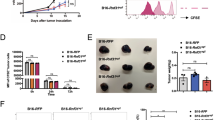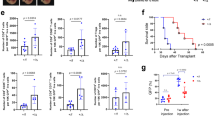Abstract
We identified IFIX as a new member of the hematopoietic interferon (IFN)-inducible nuclear protein with the 200-amino-acid repeat (HIN-200) family. Six different alternatively spliced forms of mRNA are transcribed from the IFIX gene, which are predicted to encode six different isoforms of IFIX proteins (IFIXα1, α2, β1, β2, γ1, and γ2). The IFIX proteins are primarily localized in the nucleus. They share a common N-terminal region that contains a predicted pyrin domain and a putative nuclear localization signal. Unlike IFIXα and IFIXβ, IFIXγ isoforms do not have the 200-amino-acid signature motif. Interestingly, the expression of IFIX was reduced in most human breast tumors and breast cancer cell lines. Expression of IFIXα1, the longest isoform of IFIX, in human breast cancer cell lines reduced their anchorage-dependent and -independent growth in vitro and tumorigenicity in nude mice. Moreover, a liposome-mediated IFIXα1 gene transfer suppressed the growth of already-formed tumors in a breast cancer xenograft model. IFIXα1 appears to suppress the growth of breast cancer cells in a pRB- and p53-independent manner by increasing the expression of the cyclin-dependent kinase inhibitor p21CIP1, which leads to the reduction of the kinase activity of both Cdk2 and p34Cdc2. Together, our results show that IFIXα1 possesses a tumor-suppressor activity and suggest IFIXα1 may be used as a therapeutic agent in cancer treatment.
This is a preview of subscription content, access via your institution
Access options
Subscribe to this journal
Receive 50 print issues and online access
$259.00 per year
only $5.18 per issue
Buy this article
- Purchase on Springer Link
- Instant access to full article PDF
Prices may be subject to local taxes which are calculated during checkout








Similar content being viewed by others
References
Choubey D . (2000). J. Biol. Regul. Homeost. Agents, 14, 187–192.
Choubey D, Walter S, Geng Y and Xin H . (2000). FEBS Lett., 474, 38–42.
Coradini D, Pellizzaro C, Biffi A, Lombardi L, Pirronello E, Riva L and Di Fronzo G . (1998). Anticancer Res., 18, 177–182.
Cox LS . (1997). J. Pathol., 183, 134–140.
Dawson MJ and Trapani JA . (1995). J. Cell. Biochem., 57, 39–51.
Dawson MJ and Trapani JA . (1996). J. Leukotr. Biol., 60, 310–316.
De Young KL, Ray ME, Su YA, Anzick SL, Johnstone RW, Trapani JA, Melzer PS and Trent JM . (1997). Oncogene, 15, 453–457.
Ding Y, Wen Y, Spohn B, Wang L, Xia W, Kwong KY, Shao R, Li Z, Hortobagyi GN, Hung M-C and Yan D-H . (2002). Clin. Cancer Res., 8, 3290–3297.
Doree M and Hunt T . (2002). J. Cell Sci., 115, 2461–2464.
Dotto GP . (2000). Biochim. Biophys. Acta, 1471, M43–M56.
Fairbrother WJ, Gordon NC, Humke EW, O'Rourke KM, Starovasnik MA, Yin JP and Dixit VM . (2001). Protein Sci., 10, 1911–1918.
Fang M, Liu B, Schmidt M, Lu Y, Mendelsohn J and Fan Z . (2000). Anticancer Res., 20, 103–111.
Funk JO and Galloway DA . (1998). Trends Biochem. Sci., 23, 337–341.
Gariglio M, Azzimonti B, Pagano M, Palestro G, De Andrea M, Valente G, Voglino G, Navino L and Landolfo S . (2002). J. Interferon Cytokine Res., 22, 815–821.
Gooch JL, Herrera RE and Yee D . (2000). Cell Growth Differ., 11, 335–342.
Gribaudo G, Riera L, De Andrea M and Landolfo S . (1999). FEBS Lett., 456, 31–36.
Gutterman JU and Choubey D . (1999). Cell Growth Differ., 10, 93–100.
Hingorani R, Bi B, Dao T, Bae Y, Matsuzawa A and Crispe IN . (2000). J. Immunol., 164, 4032–4036.
Johnstone RW and Trapani JA . (1999). Mol. Cell. Biol., 19, 5833–5838.
Kimchi A, Resnitzky D, Ber R and Gat G . (1988). Mol. Cell. Biol., 8, 2828–2836.
Lengyel P . (1993). Proc. Natl. Acad. Sci. USA, 90, 5893–5895.
Liepinsh E, Barbals R, Dahl E, Sharipo A, Staub E and Otting G . (2003). J. Mol. Biol., 332, 1155–1163.
MacLachlan TK, Sang N and Giordano A . (1995). Crit. Rev. Eukaryot. Gene Express., 5, 127–156.
Martinon F, Hofmann K and Tschopp J . (2001). Curr. Biol., 11, R118–R120.
Nadal A, Jares P, Cazorla M, Fernandez PL, Sanjuan X, Hernandez L, Pinyol M, Aldea M, Mallofre C, Muntane J, Traserra J, Campo E and Cardesa A . (1997). J. Pathol., 183, 156–163.
Naldini A, Carney DH, Pucci A and Carraro F . (2002). J. Cell. Physiol., 191, 290–297.
Price JE, Polyzos A, Zhang RD and Daniels LM . (1990). Cancer Res., 50, 717–721.
Shao R, Karunagaran D, Zhou BP, Li K, Lo S-S, Deng J, Chiao P and Hung M-C . (1997). J. Biol. Chem., 272, 32739–32742.
Staub E, Dahl E and Rosenthal A . (2001). Trends Biochem. Sci., 26, 83–85.
Wei W, Clarke CJP, Somers GR, Cresswell KS, Loveland KA, Trapani JA and Johnstone RW . (2003). Histochem. Cell. Biol., 119, 45–54.
Wen Y, Yan D-H, Wang B, Spohn B, Ding Y, Shao R, Zhou Y, Xie K and Hung M-C . (2001). Cancer Res., 61, 7142–7147.
Wen Y, Yan DH, Spohn B, Deng J, Lin SY and Hung MC . (2000). Cancer Res., 60, 42–46.
Xie Y and Hung MC . (1994). Biochem. Biophys. Res. Commun., 203, 1589–1598.
Yin F, Giuliano AE, Law RE and Van Herle AJ . (2001). Anticancer Res., 21, 413–420.
Yu D, Jing T, Liu B, Yao J, Tan M, McDonnell TJ and Hung MC . (1998). Mol. Cell, 2, 581–591.
Zhang JF, Hu C, Geng Y, Selm J, Klein SB, Orazi A and Taylor MW . (1996). Proc. Natl. Acad. Sci. USA, 93, 4513–4518.
Zhang RD, Fidler IJ and Price JE . (1991). Invasion Metastasis, 11, 204–215.
Zhou Y, Wang S, Yue BG, Gobl A and Oberg K . (2002). Cancer Investig., 20, 348–356.
Zou Y, Peng H, Zhou B, Wen Y, Wang SC, Tsai EM and Hung MC . (2002). Cancer Res., 62, 8–12.
Acknowledgements
We thank Drs Mien-Chie Hung, Funda Meric, Naoto Ueno, Dihua Yu, Mong-Hong Lee, and Nancy Poindexter for providing the reagents used in this study. This work was supported in part by grants from the Department of Defense (DAMD17- 99-1-9270), Texas Advanced Technology Program (003657-0082-1999), and an Institutional Research Grant from The University of Texas, MD Anderson Cancer Center (to DHY), and Cancer Center Core Grant CA16672 from the NIH. YD is the recipient of a post-doctoral fellowship from the Department of Defense (DAMD17-02-1-0451).
Author information
Authors and Affiliations
Corresponding author
Additional information
Note added in proof
During the preparation of this manuscript, a partial amino acid sequence of the N-terminal domain of IFIX protein (referred to as IFI16-like protein 1) was published (Liepinsh et al., 2003).
Rights and permissions
About this article
Cite this article
Ding, Y., Wang, L., Su, LK. et al. Antitumor activity of IFIX, a novel interferon-inducible HIN-200 gene, in breast cancer. Oncogene 23, 4556–4566 (2004). https://doi.org/10.1038/sj.onc.1207592
Received:
Revised:
Accepted:
Published:
Issue Date:
DOI: https://doi.org/10.1038/sj.onc.1207592
Keywords
This article is cited by
-
Functions and roles of IFIX, a member of the human HIN-200 family, in human diseases
Molecular and Cellular Biochemistry (2022)
-
Interferon-inducible protein, IFIX, has tumor-suppressive effects in oral squamous cell carcinoma
Scientific Reports (2021)
-
Cytosolic DNA sensing by cGAS: regulation, function, and human diseases
Signal Transduction and Targeted Therapy (2021)
-
AIM2 recognizes cytosolic dsDNA and forms a caspase-1-activating inflammasome with ASC
Nature (2009)



